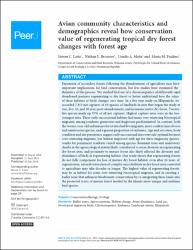/admin/item?itemID=d388aad8-9107-4b66-b83a-81f300cdadfc
Avian community characteristics and demographics reveal how conservation value of regenerating tropical dry forest changes with forest age

Ver/
Tipo de acceso
AbiertoTipo de Material
ArtículoTipo de Contenido
Investigación científicaMateria
Biodiversidad - República DominicanaAves ─ República Dominicana
Hábitats y especies
Áreas protegidas - República Dominicana
Parques nacionales
Idioma
InglésAudiencia
Técnicos, profesionales y científicosColección
- Investigación ambiental [1613]
Metadatos
Mostrar el registro completo del ítem| Sinopsis: | Expansion of secondary forests following the abandonment of agriculture may have important implications for bird conservation, but few studies have examined the dynamics of this process. We studied bird use of a chronosequence of differently-aged abandoned pastures regenerating to dry forest to better understand how the value of these habitats to birds changes over time. In a five year study on Hispaniola, we recorded 7,315 net captures of 60 species of landbirds in sites that began the study at two, five, 10, and 20 years post-abandonment, and in mature native dry forest...We studied bird communities during the northern winters of 2003–04 through 2007–08 in the buffer zone of Sierra de Bahoruco National Park, Dominican Republic where a growing human population and associated agricultural activities often conflict with park protection goals... |
| Autor(es): | Latta, Steven C.
Brouwer, Nathan L. Mejía, Danilo A. Paulino, María M. |
| Año: | 2018 |
| Publicado: | PeerJ, 6, e5217 |
| Citación: | Latta, S. C., Brouwer, N. L., Mejía, D. A., & Paulino, M. M. (2018). Avian community characteristics and demographics reveal how conservation value of regenerating tropical dry forest changes with forest age. PeerJ, 6, e5217. Recuperado de: |
| URI: | https://bvearmb.do/handle/123456789/4805
|

